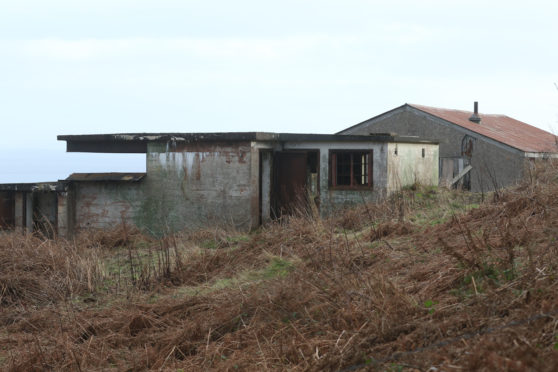A forgotten wartime base in the Highlands has finally secured protected status – but local community leaders now want investment and public access delivered.
Heritage chiefs confirmed last night that the South Sutor forts, above Cromarty on the Black Isle, have been officially designated as a “nationally important monument”.
Commissioned by Winston Churchill in 1913, the site has been described by Historic Environment Scotland (HES) as “the most complete surviving coast battery within Scotland”.
But despite its huge historical significance, many of the gun emplacements and associated buildings have fallen into disrepair and have been shut off from public view behind padlocked gates for decades.
After years of behind-the-scenes discussions, the P&J revealed in January that the naval defence complex, overlooking the mouth of the Cromarty Firth, was on the brink of being designated as a scheduled monument.
Although a few of the buildings have been excluded from the designation, the rest of the site has now been given the legal protection, which includes the requirement for special permission before any work can be carried out.
The Cromarty Community Development Trust want HES and the local landowner to go further, however, including carrying out repairs at the site and opening-up the fenced-off section of the battery for public access.
“We welcome the legal protection of the site from development provided by this scheduling,” a spokesman said.
“We would, however, question the exclusion of certain buildings on the account of health and safety, asbestos and ‘change of use’, as surely all building are crucial to the understanding and interpretation of the site.
“Also, scheduling does not require the owner to maintain or improve the site, or increase public access.
“There has been little or no maintenance since its purchase by the current owner.
“If this continues, then the benefit of scheduling may become questionable.”
With pillboxes on the rocks near the shore, and the remains of a larger camp on the headland above, the South Sutor battery guarded the strategically important Cromarty Firth naval port during both wars.
As well as gun emplacements, other structures include two battery observation posts, four magazines, one engine house, two searchlight emplacements, one mine-watching observation post, a large water tank and at least 12 other buildings for accommodation, storage and maintenance.
A spokeswoman for Historic Environment Scotland (HES) said: “South Sutor Battery, batteries and camp is now designated as a scheduled monument.
“The scheduling of the site recognises its national importance as a well-preserved example of a multi-phase coastal artillery battery, preserving rare features from both the First and Second World War.
“Occupying a strategically significant location at the entrance to the Cromarty Firth, the remains at South Sutor provide a tangible and powerful reminder of some of the defining events of the 20th century.”
She added: “South Sutor Battery will be included in our monitoring programme for scheduled monuments.
“Our field officers visit scheduled sites and their owners from time to time to check the condition, offer advice on monument management and ensure that everyone with a current interest in the sites knows about its protection.”
National importance
The batteries on the South and North Sutors, the headlands at the mouth of the Cromarty Firth, were a vital component of a national defensive system that extended from Shetland to Cornwall.
In Scotland, there were around 50 coast batteries during the First World War and around 70 during the Second World War, and they were positioned to defend strategically significant targets from amphibious and naval attack.
Historic Environment Scotland (HES) said: “The survival of many of the ancillary structures at South Sutor make this the most complete surviving coast battery within Scotland.
“The extensive survival of camouflage paint from both the First and Second World War is particularly rare. At most sites, erosion and decay processes have worn this away entirely.”
The main area of the battery is located on sloping ground between 300ft and 380ft above sea level, although elements such as the searchlights and the 4-inch World War I quick-firing battery are located much lower down towards the shoreline, at around 30ft to 65ft above sea level.
After the war, the South Sutor battery was placed on a “care and maintenance” watch before finally closing in 1956, after which it was temporarily used as a Territorial Army centre.
HES added: “This monument is of national importance because it has an inherent potential to make a significant addition to our understanding of the defence of the important naval anchorage of the Cromarty Firth and the naval base at Invergordon during the First and Second World War.
“This is a well-preserved example of a multi-phase coastal artillery battery, preserving rare features from both wars, including fixtures, fittings and camouflage paintwork.
“Occupying a strategically significant location at the entrance to the Cromarty Firth, the remains at South Sutor provide a tangible and powerful reminder of some of the defining events of the 20th century.”
